As we make our way through 2020 and the COVID19 pandemic it is tempting to feel that the long-term is too far away and to focus our attention entirely on short-term activities. This is a trap that HR leaders cannot fall into. Whilst it is important to make operational and tactical decisions to control HR costs over the next few months, it is also HR's responsibly to step back and take a longer term view to people management. 3n Strategy works with organisations to design and deliver strategic workforce planning projects, and runs public training workshops to upgrade and refresh HR leaders on their SWP skills.
The future is uncertain - but when is that not the case? Success in business is dependent on our ability to prepare for the future. Strategic Workforce Planning, or SWP, is the HR process that digests risk and unknowns, and enables the creation of long-term people strategies anchored in the plausible, business-backed futures. By doing SWP HR is able to articulate the impact of its strategies in the language of the business itself.
Why do organisations do Strategic Workforce Planning?
In normal times organisations would be advised to do strategic workforce planning as an annual exercise. By doing so HR functions ensure that their HR strategies evolve to reflect shifts in business goals and plans. Having said that, most organisations tend to start their SWP when driven by a particular need - perhaps they anecdotally know that they will face major talent and skill deficits over the next few years, or they need to plan a major transformation towards a 'Workforce of the Future'. Or perhaps at the moment, as with many organisations in 2008 during the financial crisis, they are operating within a world of increasing uncertainty and their HR function needs a way to step back and take a long term view.
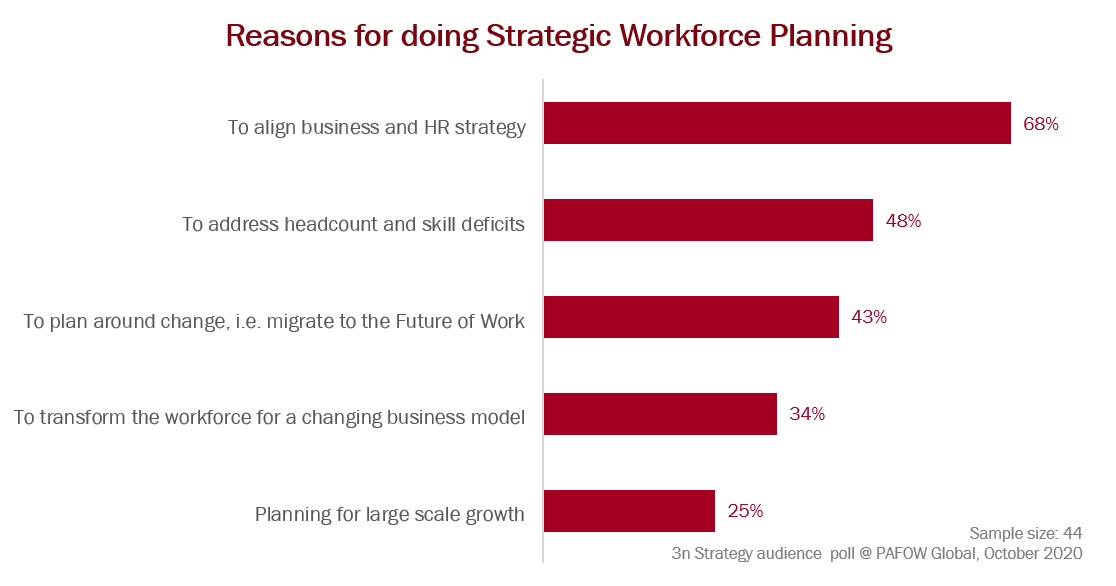
Audience poll by 3n Strategy during PAFOW Global 2020 for the drivers of Strategic Workforce Planning.
What is Strategic Workforce Planning? What do SWP outputs look like?
It can be easier to explain SWP by focusing on the end result. Different organisations may articulate and visualise it differently, and some outputs may have more detail (a benefit of working with a consultancy, usually), but they will include the same broad details:
- Business Context: A way of articulating what the business is doing and the obstacles the business is facing. This will often be based on scenarios that reflect the spectrum of possible futures. Getting these scenarios correct, and approved by the business, is critical to the success of your SWP as it creates the business context for all HR strategies.
- Critical Skills and Roles: SWP will usually focus on 'critical' talent, i.e. talent that is crucial to deliver business goals, harder to train and is not easily found within the labour markets. The exact reason for why a business considers it critical may vary, but your SWP will need to consider what is critical now and in the future.
- Forecasts: SWP outputs will articulate what critical talent the business has, what it needs in the future ("Demand"), and how the current internal critical talent will change based on historic trends ("Supply"). The way the forecasting is done may change. For example, demand may be forecasted using quantitative or qualitative techniques, or supply forecasts may increase in complexity. Ultimately though it is about identifying the two and articulating the risk the "Gap" represents to the business, i.e. if this predicted gap is not addressed what risk does the workforce represent to business delivery.
- Strategies and Accountability: Arguably the most important part of an SWP output is not the articulation of the risk in (3) but the provision of what HR is doing to address these risks. This final part of an SWP output is HR's opportunity to show off its expertise has it articulates which strategies will be employed to address critical talent deficits and surpluses - preferably leveraging its HR and people analytics teams to forecast the impact, the likelihood of the success and the cost of that particular strategy. The best organisations assign these strategies to teams/people and create targets to measure using your HR analytics and reporting tools throughout the year.
Below is a mocked up example of what 3n Strategy's SWP might look like if written now during Phase 3 ("Normalisation") of the pandemic:
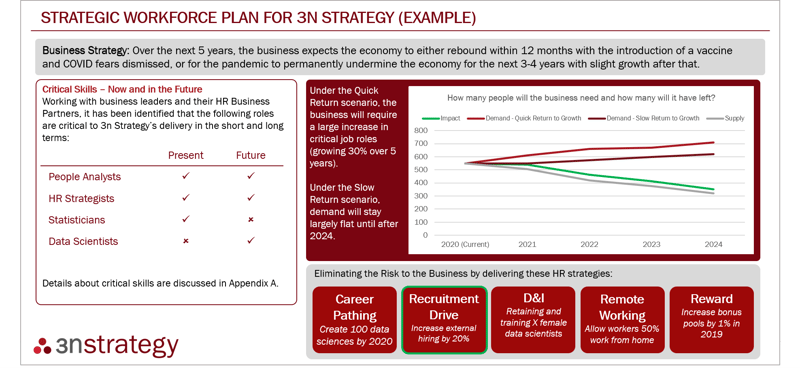
How does it differ from operational and tactical workforce planning?
SWP requires everyone to step back and take a longer-term view. Doing so creates the opportunity for people and HR leaders to think about the bigger pictures, to genuinely think more strategically and probably also more creatively. Typically everyone involved will need to employ the more strategic, consultative parts of their skill sets and think in the context of the business and problem solving. They will need to consider long-term timeframes and the risks and opportunities involved with these predictive mentalities. There are ways that the SWP can make it easier for everyone to remain disciplined and not be caught up in operational and tactically planning but it will require everyone to resist the urge to get caught up in short-term planning.
Scenarios: Defining how uncertain the future is.
Over time, the environment a business operates in will change. Some of these changes may be driven by the business (factors within the control of your business but beyond the control of HR) and more will be driven by external factors (factors beyond the control of your business). Your scenario design needs to consider how these factors will impact the future and working with the business, define the spectrum of what is likely to occur, i.e. the economy is likely to grow at minimum 1% or at most 3% during our forecast period. Note: Often your business's strategy team already has a lot of this information to begin with.
How has the pandemic changed scenario design process? It hasn't. The biggest impact of COVID19 on scenario design is that right now the future is more uncertain than usual. Some businesses may be planning for harder times, whilst others plan for growth, and some for both. These means your business will probably be less sure of the future than normal, and therefore your scenarios may diverge more than usual. This is fine though - remember, when you re-do SWP next year the world will (hopefully) be more stable and you can tweak the scenarios to reflect this reduced uncertainty and divergence in scenario design.

What type of HR and People Analytics do you need during Strategic Workforce Planning
Strategic Workforce Planning shows off HR in a strategic light, and helps build and confirm HR's credibility. This credibility is built partly by the demonstration of business knowledge and the ability to reduce the risk to business delivery. It is also demonstrated by explaining HR decisions and reasoning using facts and evidence - provided by your HR and people analytics team.
What is our current FTE in a critical job role? How often to they resign or retire? What was FTE growth last time we faced these economic conditions and can we use that to inform our future requirements? What are our skill mixes? Will our natural vertical career paths solve part of the deficit or can we use cyclical career paths? Is it feasible to go from a 15% to 18% external recruitment rate?
Throughout the process you should be leveraging your analytics teams to provide everyone engaged in the SWP process with evidence they need to make the decisions that matter to your organisation and people strategies.
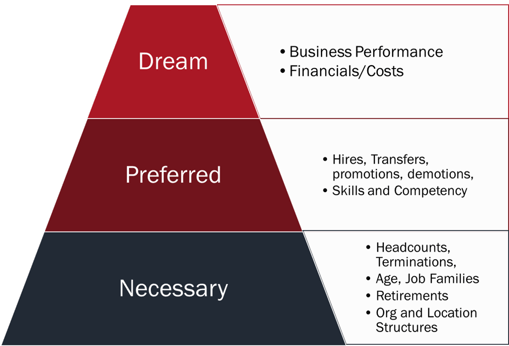
A COVID19 Impact: Opportunity for Disruptive HR and Digital Strategies
During 'normal' times SWP offers HR the opportunity to be more creative and strategic with its planning, but COVID19 has accelerated the need for changes in people management. When doing strategy design at the moment, and HR stakeholders are considering and comparing the impact and cost of different strategies, the pandemic has enabled some organisations to think wider than usual. For HR professionals who have wanted to think more outside-of-the-box, and for Digital enthusiasts who might previously have had to be more patient, this may be the opportunity to suggest more disruptive, forward-thinking strategies.
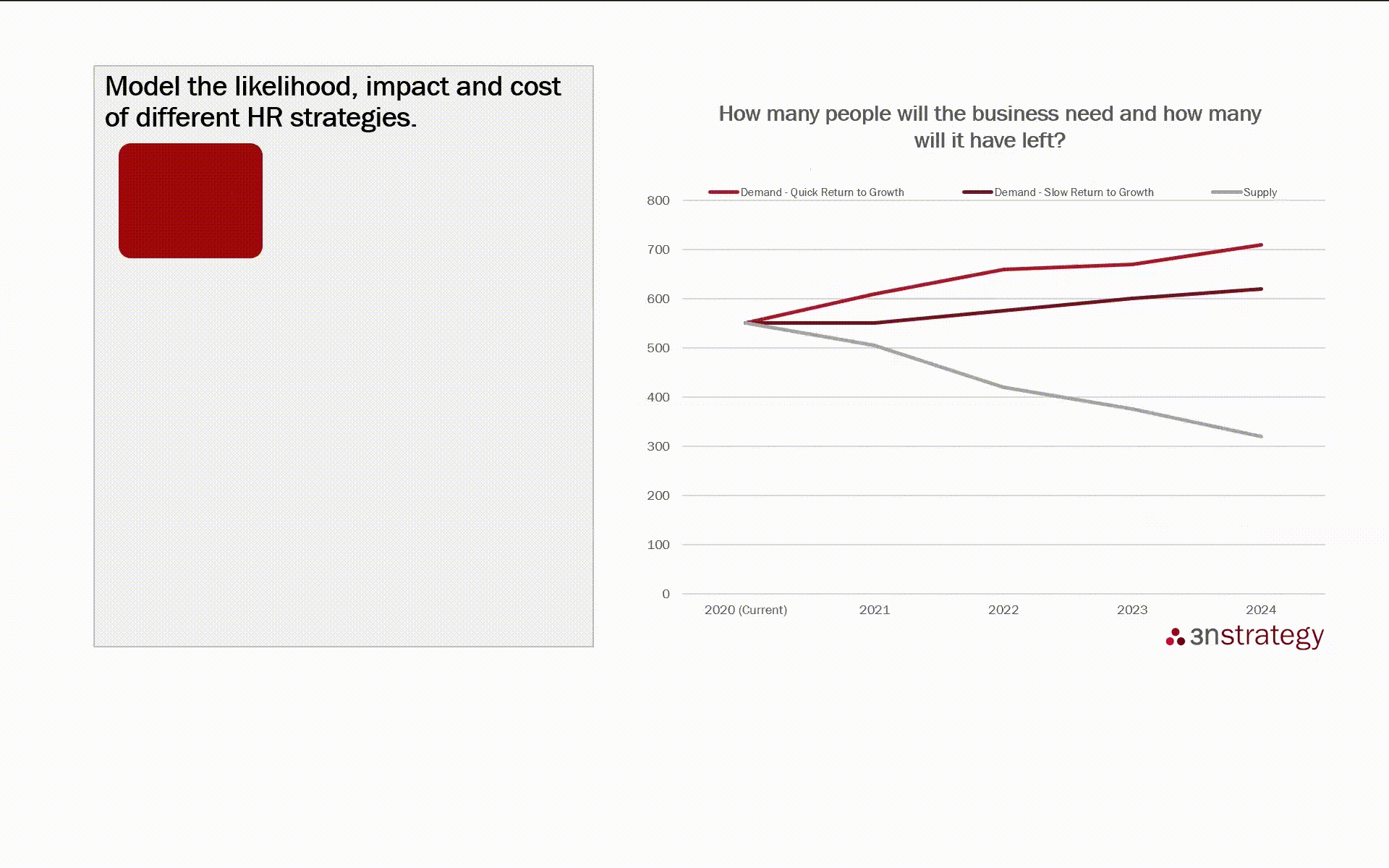
What other impacts of COVID19 on Strategic Workforce Planning might you expect?
In times of extreme business pressure it is sometimes necessary to compromise on the purist definitions of strategic workforce planning. What are some of the compromises you may be expected to make?
- Scenarios: In 'normal' times you will probably design two scenarios to articulate the spectrum of the future. In pressured environments it is sometimes not possible to get the business to think like this, and you will end up operating with one scenario for the next year. Don't worry, you can always fix this next year.
- Forecast years: Under pressure businesses cannot always think 5 years into the future - the average future forecast period in our experience - as it just seems too far away. You can settle for a short time period but you cannot let the forecast period become so short that SWP gets treated as a short-term planning exercise.
- Project timeframes: Usually the first time an organisation does SWP the process will take 4-8 for their pilot to complete. If you have the right buy-in from the business and HR leadership at the moment, you probably need to get this done ASAP.
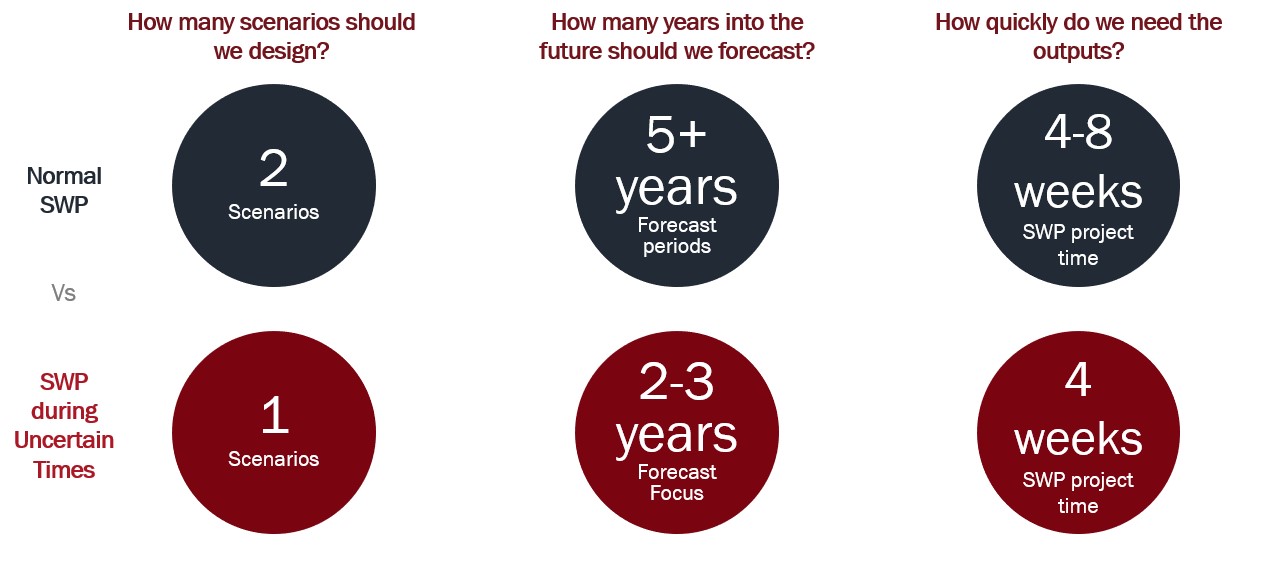
Get started now
Strategic Workforce Planning is a worthwhile exercise for any organisation to undertake at any time, but if you can get your organisation to do it during the 2020 pandemic you will be offering HR and business leaders to take and step back and consider the full picture. Uncertainty is challenging, whether it is working for or against your business in the short-term, but it is HR's responsibility to the business and its people to plan for the future. Want to learn more about Strategic Workforce Planning?
Check out 3n Strategy's consulting services or our training workshops
.png?width=2433&height=555&name=3n%20Strategy%20PNG%20Logo%20(Transparent).png)





